Nationally Designated Important Cultural Property
Arakawa Residence Visit
Apr. May Jun. Jul. Aug. Sep. Oct. Nov. Dec. 2021 Inf.
August
August 26th: Threshing
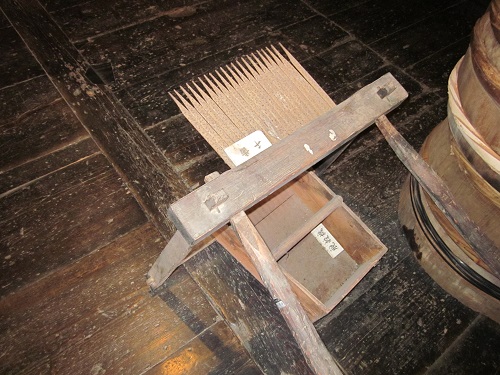 The harvested rice is hung on Hasa (rice rack) to dry and carried to
Niwa (workshop).
This is a Senba (comb thresher) that thresh rice ears.
The harvested rice is hung on Hasa (rice rack) to dry and carried to
Niwa (workshop).
This is a Senba (comb thresher) that thresh rice ears.
Holding a bundle of rice in hand, put the panicle base in a comb-shaped
groove and pulled it toward him, and threshed it.
When the efficient foot threshing machine appeared,
it gradually fell out of use.
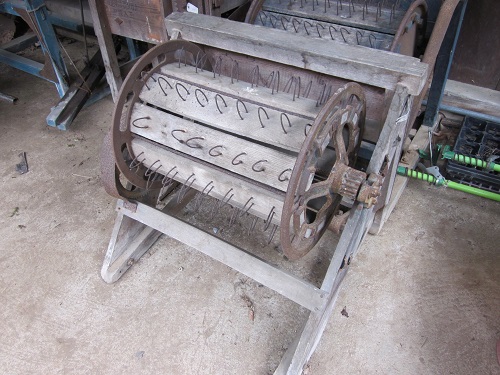 This is a foot threshing machine (Ashibumidakokuki) that thresh rice ears.
This is a foot threshing machine (Ashibumidakokuki) that thresh rice ears.
They pedaled and rotated the cylindrical shape with the inverted V-shaped wire,
and threshed it by contacting it with a bundle of rice ears held in my hand.
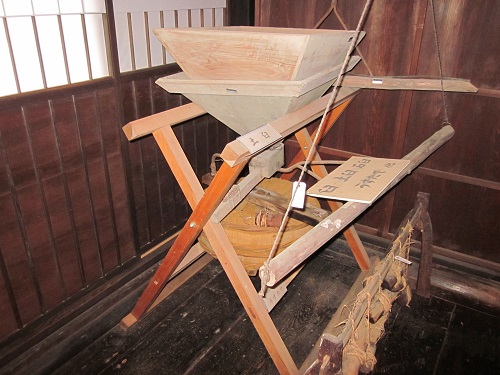 This is Dous that does hulling rice.
Hulling rice removes rice husks from Paddy to make brown rice.
This is Dous that does hulling rice.
Hulling rice removes rice husks from Paddy to make brown rice.
Dous has two upper and lower cylindrical shapes,
a rod comes out from the upper cylinder and has a handle at the tip.
A person pushes and pulls the handle to rotate the upper cylinder.
If you put the Paddy from the top and rotate it,
brown rice and rice husks will come out from the side.
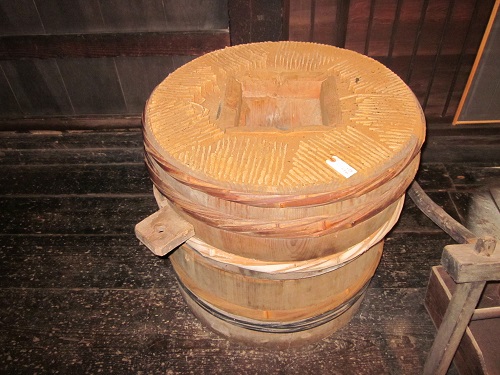 Dous has many teeth of soil and wood in the body of the tub,
and there are radial grooves in the part where the top and bottom meet.
Dous has many teeth of soil and wood in the body of the tub,
and there are radial grooves in the part where the top and bottom meet.
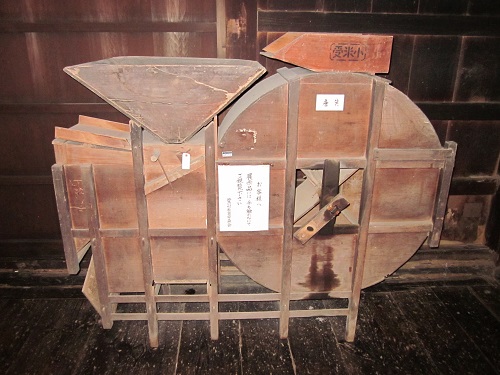 Toumi uses wind power to remove rice and bean chaff and saya.
Toumi uses wind power to remove rice and bean chaff and saya.
Turn the impeller inside the right side with the hand-cranked handle
to send the wind to the left.
Put rice and beans in the inverted triangle on the upper left
and drop them little by little.
Heavy rice and beans come out of the lower window, while light rice husks
and pods are blown out of the leftmost opening and sorted.
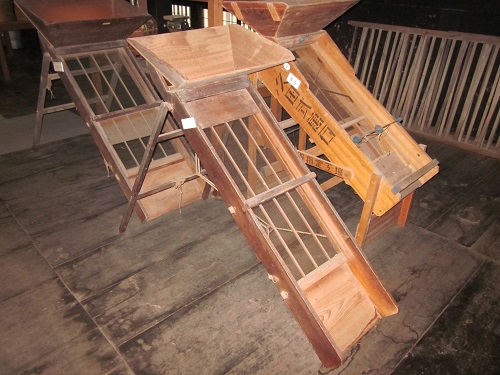 This is Sengokutooshi that separates brown rice and rice husks
after hulling rice,
and removes brown rice waste rice and crushed rice of rice polishing.
This is Sengokutooshi that separates brown rice and rice husks
after hulling rice,
and removes brown rice waste rice and crushed rice of rice polishing.
Put them in the inverted triangle at the top and drop
and select the meshed slopes.
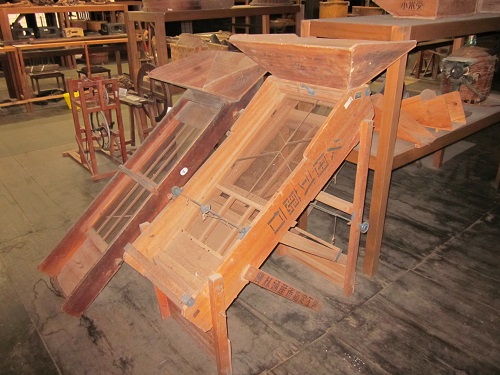 Mangokutooshi is the same as Sengokutooshi.
The difference is one or three nets.
Mangokutooshi is the same as Sengokutooshi.
The difference is one or three nets.
August 26th: Weaving (Hataori)
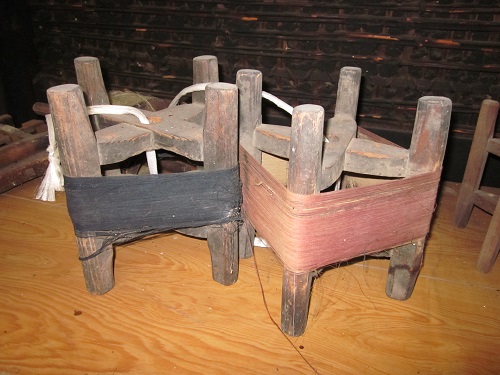 These are spool that winds the yarn.
These are spool that winds the yarn.
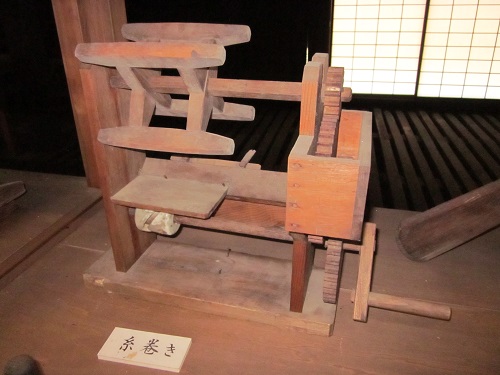 This is a yarn winder that winds the yarn on a spool.
This is a yarn winder that winds the yarn on a spool.
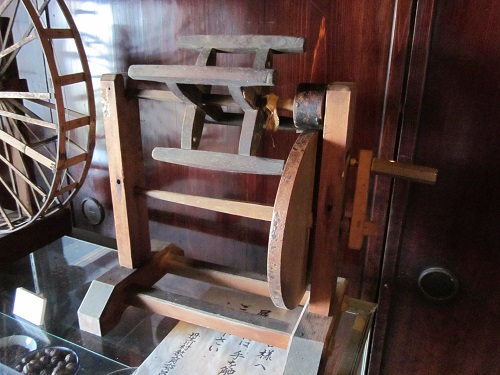 This is a yarn winder that winds the yarn on a spool.
This is a yarn winder that winds the yarn on a spool.
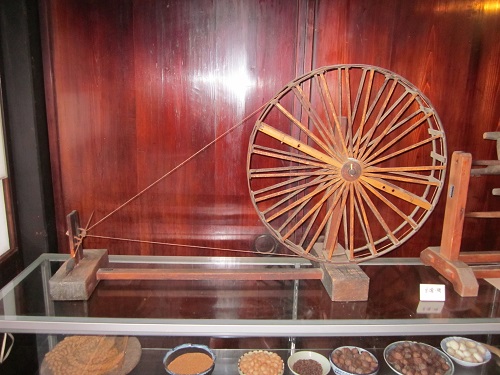 This is a reeling machine that twists from cocoons, hemp, etc.
This is a reeling machine that twists from cocoons, hemp, etc.
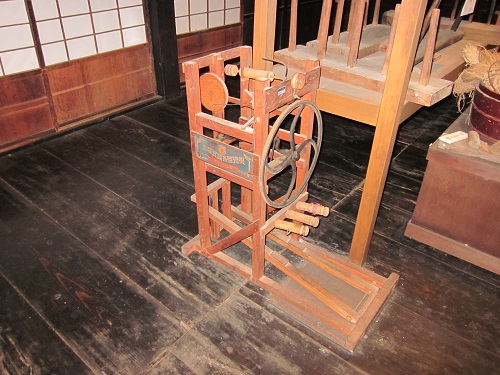 This is Sanshiseiriki.
This is Sanshiseiriki.
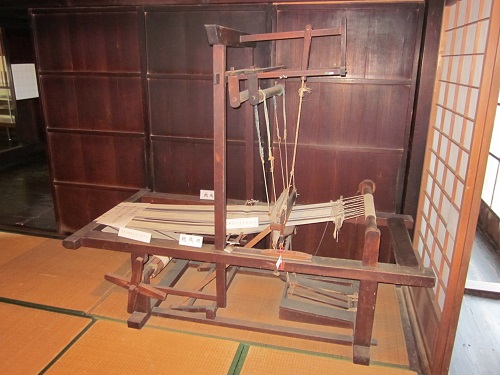 This is a weaving machine (Hataoriki) that weaves cloth.
This is a weaving machine (Hataoriki) that weaves cloth.
It is a machine that weaves by alternately combining warp and weft.
Warps are stretched on the left and right.
Press on either pedal on the lower right with your foot to separate
the warps up and down.
In between, weft is stretched to the other side by passing through
a shuttle containing a weft.
The weft is struck toward the worker with an reed (Osa)
and the warp and weft are incorporated.
This is repeated to weave the fabric.
After weaving to some extent, rotate the cloth wrapping tool
on the right side to wind up the cloth.
The person sits on the rightmost seat plate and works.
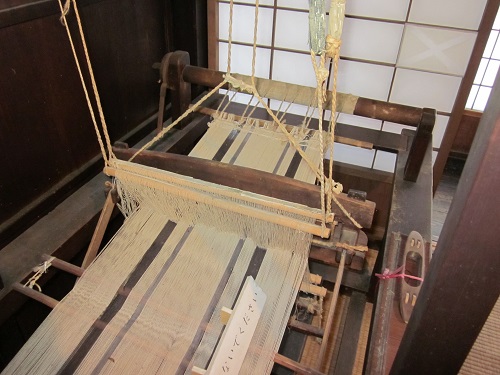 This is a weaving machine (Hataoriki) seen from the left.
There are two horizontal bars at the
end of the four strings hanging from the top,
and each thread with a hole in the center where the thread is knitted
and the warp thread is passed through is attached every other time.
This part is the heddle (Soukou).
This is a weaving machine (Hataoriki) seen from the left.
There are two horizontal bars at the
end of the four strings hanging from the top,
and each thread with a hole in the center where the thread is knitted
and the warp thread is passed through is attached every other time.
This part is the heddle (Soukou).
The warp is threaded through the heddle hole.
When you step on the pedal,
the string is pulled and one heddle is lifted,
and half the warp is risen.
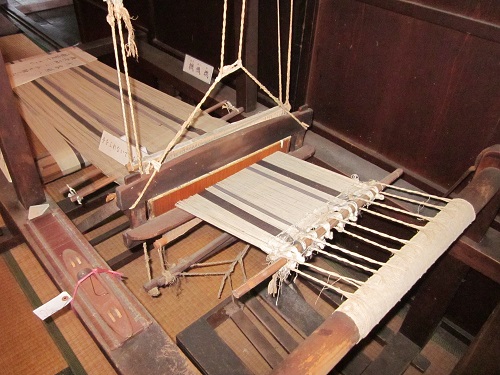 This is a weaving machine (Hataoriki) seen from the right.
At the end of the two strings hanging from the top is attached
a reed (Osa) that looks like the teeth of comb lined up.
Warps are threaded one by one through the gaps between
the teeth of the reed (Osa).
This is a weaving machine (Hataoriki) seen from the right.
At the end of the two strings hanging from the top is attached
a reed (Osa) that looks like the teeth of comb lined up.
Warps are threaded one by one through the gaps between
the teeth of the reed (Osa).
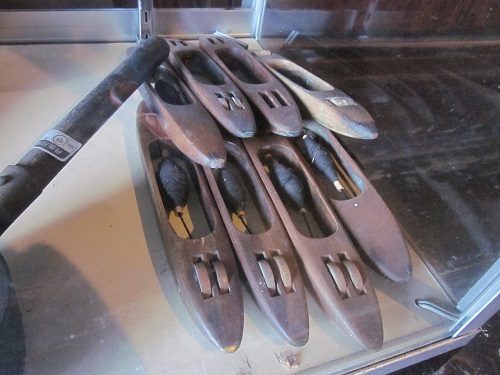 These are tool used to pass weft threads between warp threads
when weaving cloth.
These are tool used to pass weft threads between warp threads
when weaving cloth.
It has 4 rollers to run smoothly over the warp.
In the center is a bobbin with a weft wound.
August 16th: Dozo
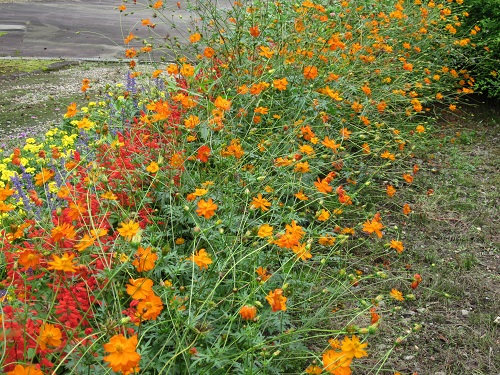 In the flower bed, orange cosmos flowers were blooming beautifully.
In the flower bed, orange cosmos flowers were blooming beautifully.
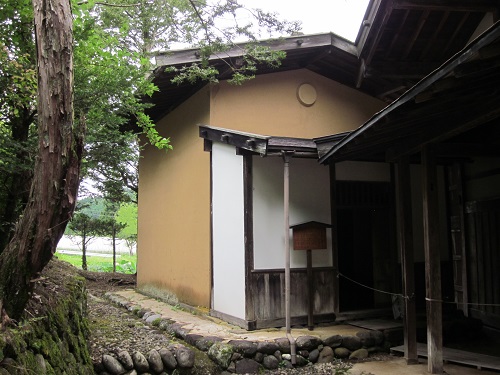 The Storehouse (Dozo) is a two-story gabled structure
with the width is 3 ken (5.4 m) and the depth is 2 ken (3.6 m),
and the entrance to a house at the gable side.
The Storehouse (Dozo) is a two-story gabled structure
with the width is 3 ken (5.4 m) and the depth is 2 ken (3.6 m),
and the entrance to a house at the gable side.
It has Kuramae with a pent roof of the depth is 1.5 ken (2.7 m).
(For details, please refer to "Information")
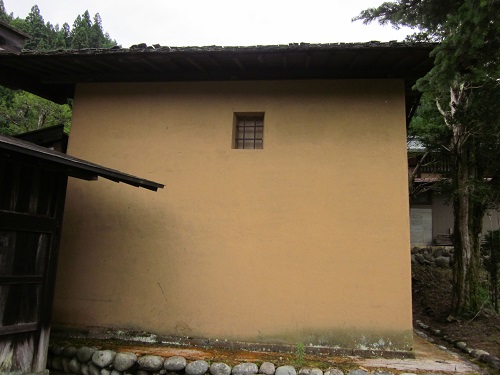 The Dozo is plastered with ocher soil.
There is one small window on the second floor.
The Dozo is plastered with ocher soil.
There is one small window on the second floor.
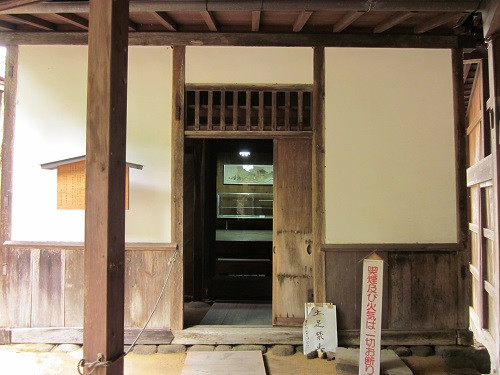 A board door is erected at the entrance of the Dozo.
A board door is erected at the entrance of the Dozo.
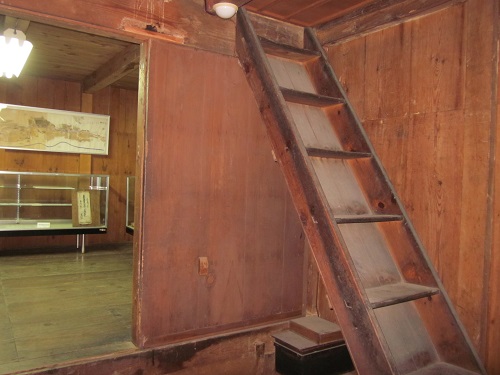 At the entrance of the Dozo,
there is a staircase that goes up to the second floor.
At the entrance of the Dozo,
there is a staircase that goes up to the second floor.
There is a board door at the entrance.
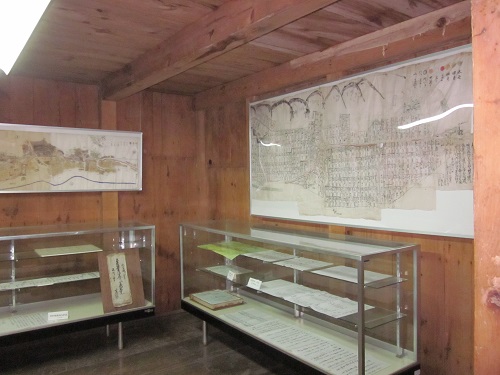 Old documents are displayed inside the Dozo.
Old documents are displayed inside the Dozo.
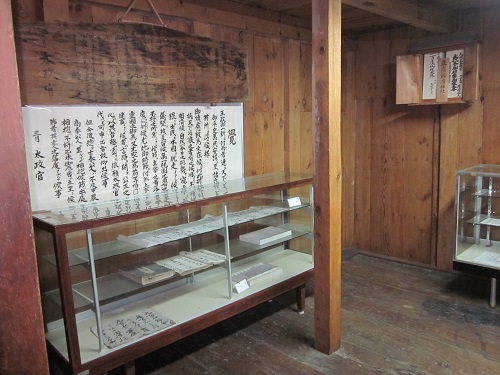 Inside the Dozo
Inside the Dozo
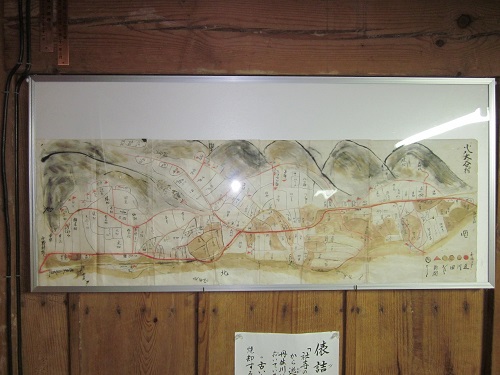 An old map of Otani Village is on display.
An old map of Otani Village is on display.
Back
<< Home < Back Next >